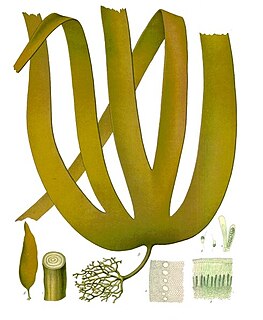
The Prorocentrales are a small order of dinoflagellates. They are distinguished by having their two flagella inserted apically, rather than ventrally as in other groups. One flagellum extends forward and the other circles its base, and there are no flagellar grooves. This arrangement is called desmokont, in contrast to the dinokont arrangement found in other groups. Accordingly, the Prorocentrales may be called desmoflagellates, and in some classifications were treated as a separate class Desmophyceae.

Palmaria palmata, also called dulse, dillisk or dilsk, red dulse, sea lettuce flakes, or creathnach, is a red alga (Rhodophyta) previously referred to as Rhodymenia palmata. It grows on the northern coasts of the Atlantic and Pacific Oceans. It is a well-known snack food. In Iceland, where it is known as söl, it has been an important source of dietary fiber throughout the centuries.

Laminariaceae is a family of brown algal seaweeds, many genera of which are popularly called "kelp". The table indicates the genera within this family. The family includes the largest known seaweeds: Nereocystis and Macrocystis.

The Fucales (fucoids) are an order in the brown algae. The list of families in the Fucales, as well as additional taxonomic information on algae, is publicly accessible at Algaebase.

Chlorococcales is an order of green algae in the class Chlorophyceae. Individual specimens are sometimes found in soil, but mostly in fresh and marine waters. The order contains approximately 780 species.

Sargassaceae is a family of brown algae in the order Fucales.

Cruoria is a genus of crustose red alga – that is, a seaweed.
Nemoderma is the only genus in the family Nemodermataceae and order Nemodermatales of the brown algae. The genus contains only a single species, Nemoderma tingitanum.
Dasycladus is a genus of green algae in the family Dasycladaceae. Dasycladus is a marine species.

Zygnema is a genus of freshwater filamentous thalloid alga comprising about 100 species. A terrestrial species, Z. terrestre, is known from India. Zygnema grows as a free-floating mass of filaments, although young plants may be found anchored to streambeds with a holdfast. The filaments form a yellow-green to bright green colored tangled mat, and are composed of elongate barrel-shaped cells, each with two star-shaped (stellate) chloroplasts arrayed along the axis of the cell.
The Trebouxiales are an order of green algae in the class Trebouxiophyceae. It is often found in Estonia.

Dilsea is a red algae genus in the Dumontiaceae family.
Chrysococcus elegans is a species of golden algae in the family Dinobryaceae. It is a freshwater species found in North America, specifically the Northwest Territories in Canada.
Navicula festiva is a species of algae in the family Naviculaceae which occurs in North American rivers.

Udotea flabellum is a species of photosynthetic macroalgae. It is commonly found in shallow waters around Florida and Belize in sandy areas, sea grass beds, and coral reefs. It is known for its antimicrobial properties and is also being used in cancer treatment studies.
Scotinosphaera is a genus of algae belonging to the family Scotinosphaeraceae.
Kephyrion is a genus of algae belonging to the family Dinobryaceae.










